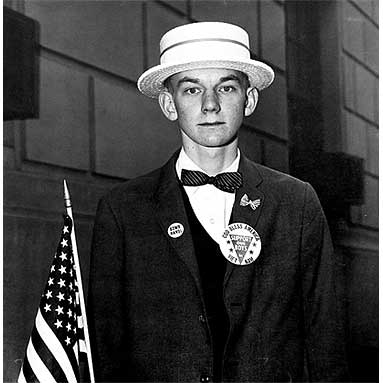My first encounter with Diane Arbus' images was in 1982 on the back cover of a 12" EP by the Sex Gang Children. They were an art school post punk band producing a strange collection of gothic type apocalyptic rantings (typical student stuff). At the time I didn't know whose photos were on the cover as there is no reference on the sleeve. I assumed that they were taken for the cover to underpin the shock value and mystery around the band. Almost 30 years later and Arbus' images still facinate me whilst, I have to say, the Sex Gang Children's 'Beast' EP hasn't survived so well!
The exhibition at Tate Modern takes over 3 rooms and includes 'a box of ten photographs', a group of ten photographs selected and printed by Arbus as her definative portfolio during her lifetime. Diane Arbus is known for taking pictures of people on the periphery of society, from circus people to inmates in mental hospitals and nudest camps and had a committment 'to photograph everybody'.
Arbus is generally thought of as sympathetic towards her subjects but this is not a view shared by all. Germaine Greer's experience of being photographed by Arbus is less complimentary (http://www.guardian.co.uk/artanddesign/2005/oct/08/photography). Most of Arbus' portraits do not appear to over dramatise the subject. For me, she doesn't try to make people look like freaks but nor does she make any attempt to take them in a flattering way. The people themselves are the interest, not the situations they are put in and quite often unsettling in their own right. The context in which the subjects are put is usually quite subtle. Perhaps an exception to this is the 'boy with a toy hand grenade' who is in a very deliberate pose. I always been a fan of this picture and it was in fact one of the images used on the EP I mentioned earlier. However, I have only recently seen the contact sheet below that shows some alternative shots taken at the time. These show the boy in a completely different light, from a confused angry child from a broken home to a boy without a care enjoying a day in the park with the rest of the family, demonstrating how a photographer can control the emotions and thoughts of the viewer. Interestingly, the final image is the only one showing the boy in this light.

The following pictures are both in the collection at the Tate and are typical subjects for Arbus (if you can call any of them a typical subject).
Teenage couple on Hudson Street NYC 1963. This image shows a young couple that frankly look old before their time. There is no reference point for scale in the picture but both of them look rather petite. They are both smartly dressed but the shot is taken on what looks like a run down backstreet with litter and doors that open on to the street. Does this point to where they live or just where she met them? A subtle background but one that sets the tone for the image.

Boy with a straw hat, NYC 1967. Clearly taken outside an offical building of some kind, this boy looks indocrinated to the point where he even looks like he was dressed by someone else. Slightly awkward looking and not sure what to do next. For me, this underpins a scary view of the American way of life.

Jose Navarro has just blogged about rephotography and I have recently been to Bradford National Media Museum to see (amongst others) Daniel Meadows' early works which included updated portraits of people taken in his earlier career. Interestingly I have just found this image from Feb 2011, so quite recent, of the twins from 'Identical Twins, Roselle, New Jersey, 1967' which is one of Arbus' most famous works. They don't remember the day they entered photographic history but they still have the dresses (which are green). Their parents tried to stop republication of the image. I do ask myself sometimes when I look at photos such as Arbus' 'what what happened to these people?'. I'd like to know what became of the boy with the hand grenade.

The exhibition shows a wide range of Arbus' work even including a self portrait taken early on when she was pregnant. I have usually draw a picture in my head of what a photographer looks like when I look at their work so it's always interesting to see what they really look like.

I have been to a large number of exhibitions this past year but this was one of the exhibitions I was most looking forward to and it did not disappoint. Arbus had an eye for capturing people on the edge of society and a unique way of capturing them.
No comments:
Post a Comment